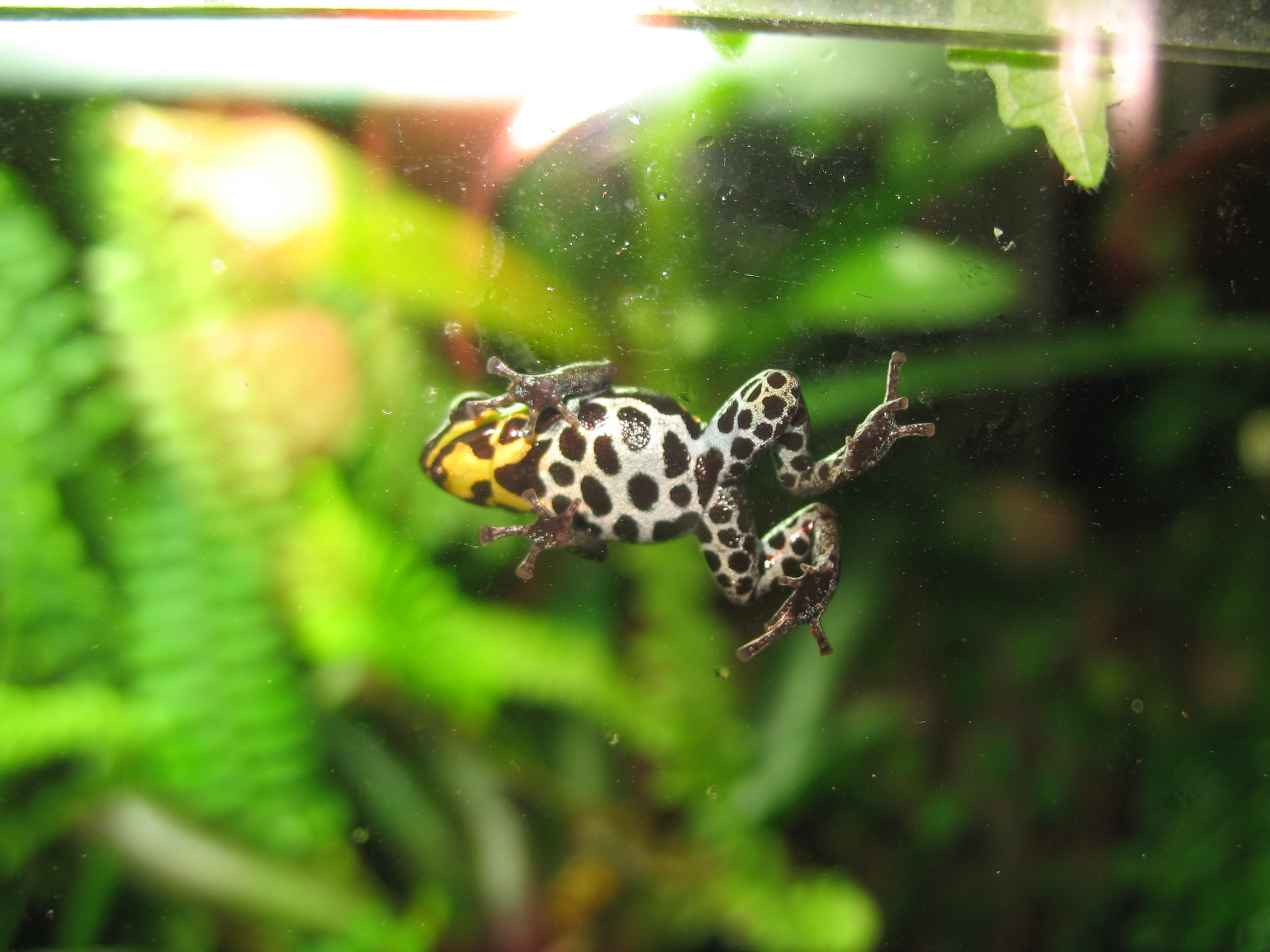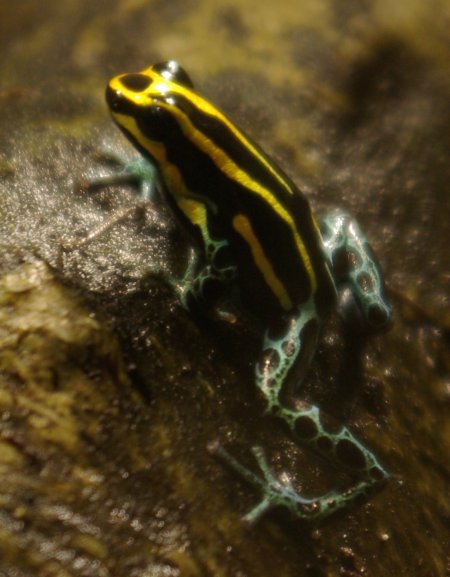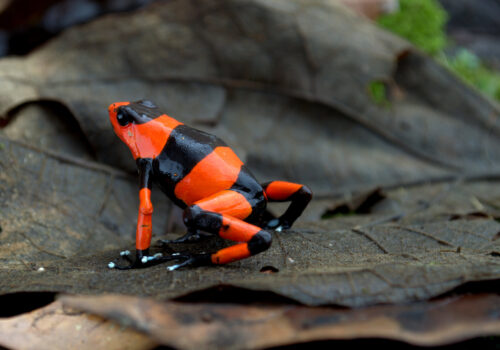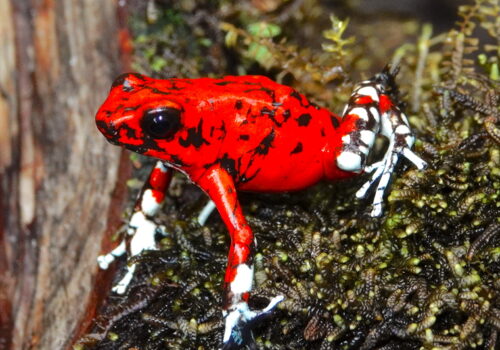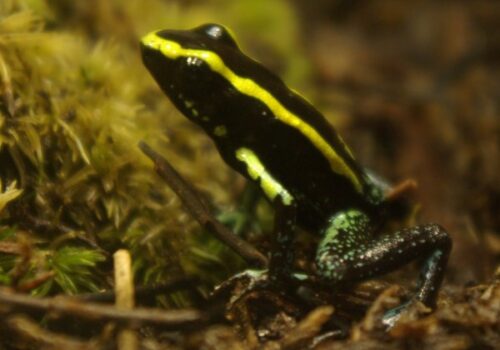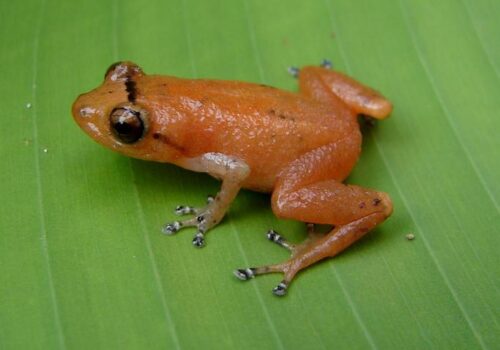- Jewels of the Rainforest: Discovering the Amazonian Poison Dart Frog <em>Ranitomeya ventrimaculata</em>
- Taxonomy and Classification
- Natural Habitat: Life in the Vibrant Amazon Basin
- Physical Characteristics: Colorful Tiny Marvels
- Behavior and Life Cycle: Secrets of Survival
- Ecological Role: Tiny Frog, Tremendous Impact
- Threats and Conservation Status
- Cultural and Scientific Significance
- Conclusion: Safeguarding the Amazon's Tiny Treasure
Jewels of the Rainforest: Discovering the Amazonian Poison Dart Frog Ranitomeya ventrimaculata#
Amid the lush emerald tapestry of the Amazon rainforest, speckled with vibrant blossoms and echoing with an orchestra of life, dwells one of the most captivating yet diminutive inhabitants—the Amazonian poison dart frog (Ranitomeya ventrimaculata). This tiny yet enigmatic creature, also commonly known as the Reticulated poison dart frog or Amazonian thumbnail dart frog, offers an exquisite glimpse into the astonishing biodiversity hidden within Earth’s largest tropical rainforest ecosystem.
Small enough to perch comfortably atop a fingertip, Ranitomeya ventrimaculata belies its size with a strikingly beautiful coloration and a complex array of behaviors that continue to delight scientists and wildlife enthusiasts alike. Possessing potent toxins, intriguing parental care, and a remarkable ability to thrive in specialized microhabitats, this little amphibian is more than worthy of an intimate exploration and respectful admiration.
Taxonomy and Classification#
Scientifically named Ranitomeya ventrimaculata, this spectacular amphibian belongs within the family Dendrobatidae, a family renowned globally as poison dart frogs due to the potent alkaloid toxins produced by many of its members. Initially classified under the genus Dendrobates, evolving genetic studies led researchers to recognize its distinct characteristics, reassigning it under Ranitomeya in 2006, a genus distinguished by its small size and unique egg deposition habits.
Close relatives of R. ventrimaculata, such as Ranitomeya imitator and Ranitomeya reticulata, similarly display vivid coloration patterns and are distributed across overlapping ranges, prompting ongoing studies into their genetics, mimicry patterns, and ecological relationships.
Natural Habitat: Life in the Vibrant Amazon Basin#
The vibrant yet elusive Amazonian poison dart frog inhabits primary lowland rainforests scattered across eastern Ecuador, northeastern Peru, southern Colombia, northwestern Brazil, and adjacent portions of the immense Amazon Basin. Preferring territories characterized by abundant rainfall, high humidity, and consistent temperatures, the species thrives within pristine, undisturbed tropical ecosystems.
Microhabitat Niches and Canopy Highways#
Unlike many amphibians that occupy lower forest layers, Ranitomeya ventrimaculata has adapted to life primarily within the tree canopy, becoming experts in navigating the intricate vertical world of bromeliads and epiphytic plants. These dense clusters of vibrant bromeliads, high up among great rainforest giants, provide the ideal refugia from predators and hold tiny pools of rainfall, providing vital nurseries essential for tadpole development.
Through incredible evolutionary adaptation, these frogs skillfully maneuver within vertical gardens several meters above forest floors, a veritable maze removed from terrestrial predators and competitors, creating an ecosystem within an ecosystem.
Physical Characteristics: Colorful Tiny Marvels#
At just 15 to 20 millimeters in length when fully grown, Ranitomeya ventrimaculata‘s size is astoundingly deceptive. Despite its minuscule scale, this frog commands attention through its striking appearance and carefully calibrated hues designed to signal danger to potential predators—a phenomenon called aposematism.
Dazzling Patterns for Predator Avoidance#
The dorsal side of the Amazonian poison dart frog features a mesmerizing intricate web-like pattern of black, vivid yellows, greens, oranges, or reds. These startling, jewel-toned markings effectively warn predators of the frogs’ potent toxicity, a defense mechanism honed over generations of ecological evolution. Underneath, their bellies showcase contrasting hues, with dark spotting set against lighter tones—hence their Latin name “ventrimaculata,” meaning “spotted belly.”
The skin of Ranitomeya ventrimaculata also displays remarkable adaptations; it secretes powerful alkaloid toxins derived primarily through its specialized insect-rich diet. Although harmless if handled carefully, improper or careless contact can cause irritation upon handling—a poignant warning that even nature’s smallest creatures can carry formidable defenses.
Behavior and Life Cycle: Secrets of Survival#
Amid dense foliage, bromeliad “water tanks,” and suspended droplets of rainwater, the reticulated poison dart frog carefully orchestrates its secretive existence. Like many dendrobatids, Ranitomeya ventrimaculata demonstrates fascinating levels of parental care and complex social interaction quite extraordinary for an organism of its size.
Diet and Feeding Behaviors#
Their diet predominantly consists of minute arthropods—tiny ants, mites, and miniature insects abundant within rainforest understory vegetation and bromeliad ecosystems. Through precision leaps and keen eyesight optimized for small prey detection, these frogs capture their meals rapidly, adeptly supplementing their defenses by absorbing toxins provided by their insect prey. Remarkably, captive breeding studies demonstrate that frogs deprived of these insects progressively lose their potency, underscoring their wholly symbiotic relationships with native prey.
Complex and Devoted Parental Care#
Mature frogs court through species-specific calls, crystal-clear chirps and buzzes that resonate softly through rainforest canopies. A receptive female selects the carefully scouted breeding site, commonly situated on bromeliad leaves or within sheltered leaf axils filled with rainwater. Unlike many amphibians that deposit eggs en masse in ponds, Ranitomeya ventrimaculata lays just a few eggs, which the male vigilantly guards against predation and desiccation.
Upon hatching, the male frog displays extraordinary commitment, transporting individual tadpoles upon his back and carefully distributing them—one tadpole per bromeliad pool—to increase survival rates. This meticulous nursery-management strategy significantly mitigates cannibalism among competing larvae, further showcasing the species’ sophisticated parental behaviors.
Ecological Role: Tiny Frog, Tremendous Impact#
Ranitomeya ventrimaculata, like many amphibian species, holds immense ecological importance within their rainforest environment. As predators of minute arthropods, they significantly influence insect populations, helping regulate delicate rainforest ecosystems in subtle yet critical ways.
Simultaneously, as prey for larger predators, their presence contributes to maintaining rich, highly interconnected food webs, signaling ecosystem health. Amphibians like Ranitomeya ventrimaculata, sensitive to environmental disturbances, often function as essential biological indicators, their declining populations urgently warning us of contaminated habitats or negative ecosystem shifts.
Threats and Conservation Status#
While currently classified as Least Concern by the IUCN Red List, Ranitomeya ventrimaculata is not immune from escalating threats. Habitat degradation and deforestation of Amazonian regions, driven by logging, agricultural expansion, illegal mining, and human encroachment, severely threaten their highly specialized habitats.
Additionally, growing international trade interest among specialized amphibian collectors demands consistent regulation and monitoring to prevent exploitation. Climate change impacts, altering rainfall patterns and temperature regimes, further jeopardize delicate aquatic microenvironments crucial for their reproduction cycle.
Cultural and Scientific Significance#
Historically utilized cautiously by indigenous cultures, poison dart frogs—including Ranitomeya ventrimaculata—occasionally influenced traditional hunting practices, though documented cases with this specific species remain less frequent compared to its more toxic South American relatives (such as Phyllobates species).
Scientifically, poison dart frogs attract global research efforts ranging from studying novel pharmaceutical applications of their toxins to examining evolutionary genetics, mimicry systems, and behavior ecology that deepen understandings of biodiversity and rainforest conservation.
Conclusion: Safeguarding the Amazon’s Tiny Treasure#
Ranitomeya ventrimaculata sits at the crossroads of ecological wonder, evolutionary artistry, and conservation urgency. Although diminutive in stature, its role within pristine rainforest habitats illustrates nature’s harmony, complexity, and endless creativity. Conserving the habitats of this marvelous creature not only protects a unique frog species but secures the ecological vibrancy and boundless diversity essential for the well-being of our shared planet.
We all have a role to play, whether advocating global conservation, supporting local rainforest guardianship initiatives, or simply respecting nature’s delicate balance in our daily lives. The enchanting journey of Ranitomeya ventrimaculata reminds us vividly that in preserving Earth’s smallest wonders, we indeed preserve the grandest beauty imaginable.







